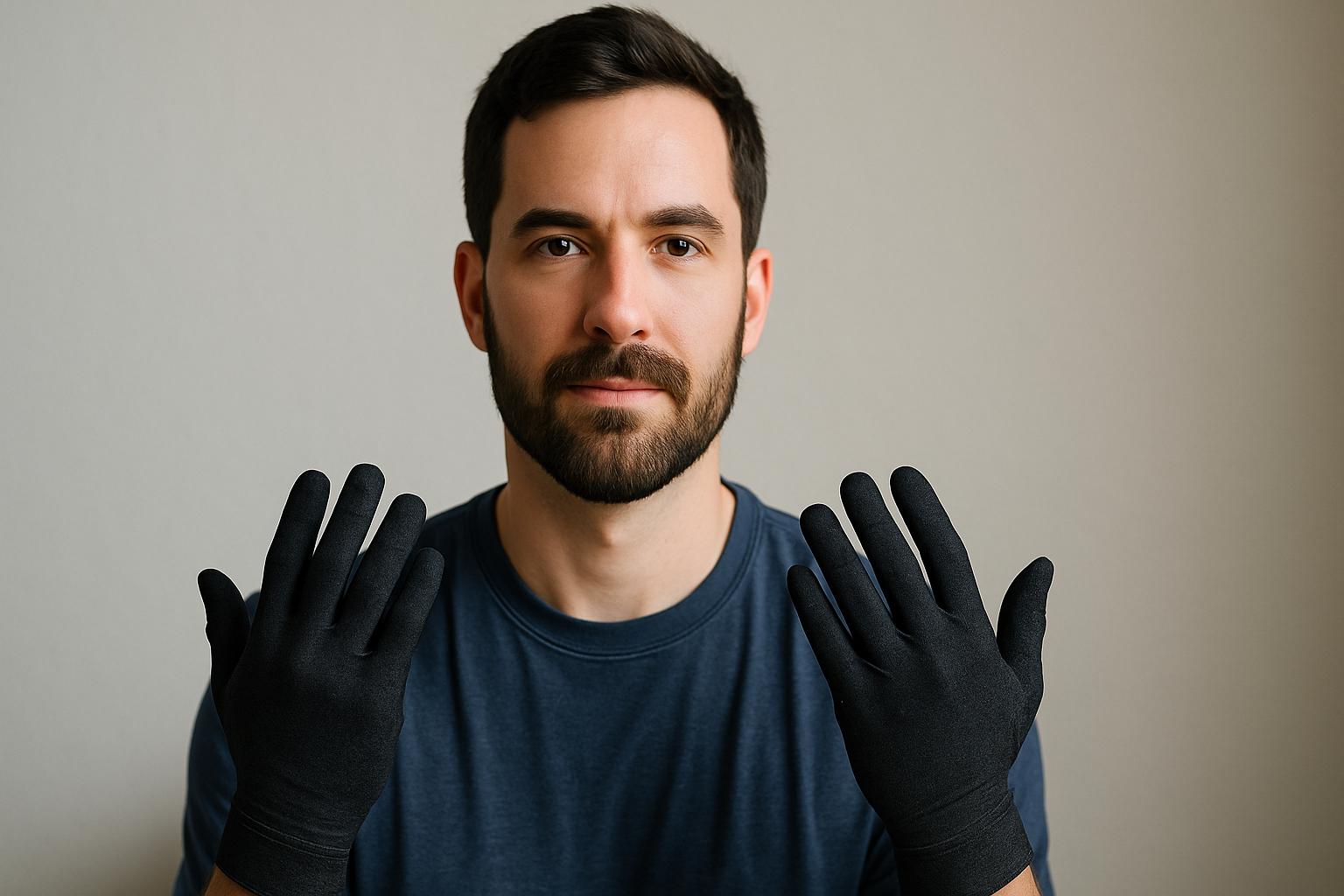Vein problems in the hands, such as swelling, poor circulation, or visible varicose veins, can cause discomfort and affect daily activities. Many people turn to compression gloves as a potential solution, since they are known to improve circulation, reduce swelling, and support joint mobility. But an important question remains: do compression gloves actually help with veins, or are their benefits limited to arthritis and stiffness relief?
In this article, we’ll explore how compression gloves work, what effect they may have on vein health, and whether they can be a useful tool for managing venous discomfort in the hands.
How can compression gloves support vein health in the hands?
When people think about compression therapy, they often picture stockings or sleeves designed for the legs. Yet, the same principles apply to the hands. Just as compression stockings improve circulation in the legs, compression gloves can promote healthier veins and better blood flow in the hands. For individuals dealing with venous discomfort, swelling, or visible vein issues, these gloves may offer a safe, non-invasive way to reduce symptoms and improve daily comfort.
The basics of vein health in the hands
The veins in the hands are responsible for carrying blood back to the heart against gravity. Because the hands are frequently used and often exposed to cold or stress, they are prone to circulation problems. Poor venous return can cause swelling, visible varicose veins, or a sensation of heaviness in the fingers. Over time, compromised circulation can make the hands feel cold, stiff, or uncomfortable, particularly during repetitive tasks.
Maintaining healthy veins in the hands is not only about aesthetics but also about functionality. Healthy blood flow ensures that tissues receive enough oxygen and nutrients, while also preventing the build-up of excess fluids that cause swelling.
How compression gloves apply pressure
Compression gloves work by applying gentle, consistent pressure across the hand and fingers. This pressure supports the veins, helping them carry blood more efficiently back to the heart. By reducing the diameter of the veins, the gloves improve blood velocity, preventing pooling of blood in the extremities. This mechanism is particularly useful for individuals who experience swelling, venous insufficiency, or early signs of varicose veins in the hands.
The pressure also assists in lymphatic drainage, which is closely linked to venous health. By minimising fluid retention, compression gloves reduce the strain on veins, preventing them from becoming more distended or visible.
Reducing swelling and discomfort
Swelling in the hands is often caused by fluid retention, which occurs when veins and lymphatic vessels struggle to circulate blood and fluids effectively. Compression gloves counteract this by limiting oedema, which not only reduces discomfort but also relieves the stress placed on the veins. For people with conditions such as arthritis or repetitive strain injury, this dual effect less swelling and better venous support improves both function and comfort.
Improving circulation and warmth
Another way compression gloves support vein health is by improving overall circulation and warmth. Cold hands are a common sign of restricted blood flow, which can put extra strain on the veins. By stimulating circulation, the gloves help maintain warmth, which in turn relaxes blood vessels and improves their efficiency. This is particularly beneficial for individuals with Raynaud’s syndrome or those who suffer from cold-induced vein problems.
Preventing further venous damage
While compression gloves are not a cure for varicose veins or venous insufficiency, they can play a preventative role. By reducing the strain on veins, they slow the progression of venous issues and help manage symptoms before they become more severe. This preventative aspect makes them valuable for people who use their hands intensively, whether for typing, crafting, or manual labour.
Practical benefits for daily life
From a practical standpoint, compression gloves are easy to wear and integrate into daily routines. They can be worn during the day to support hands during activity or overnight to reduce swelling and stiffness. The feeling of lighter, warmer, and more comfortable hands is not just a physical benefit but also contributes to psychological reassurance. Many users report feeling more confident knowing that their vein health is actively supported.
Scientific parallels with other compression therapies
While there is limited research specifically on compression gloves and vein health in the hands, the scientific principles are well established through decades of study on compression stockings and sleeves. These studies consistently show that compression supports venous return, reduces oedema, and improves circulation. By applying these same principles to the hands, it is reasonable to conclude that compression gloves provide similar benefits tailored to smaller extremities.
Are compression gloves recommended for varicose veins in the hands?
Varicose veins are often associated with the legs, but they can also affect the hands. These swollen, twisted veins appear when blood flow is hindered, usually due to weakened vein walls or valves. While varicose veins in the hands are less common than in the lower limbs, they can cause discomfort, swelling, and cosmetic concerns. Many people wonder whether compression gloves widely used for arthritis, swelling, and circulation issues are also recommended for managing varicose veins in the hands.
Understanding varicose veins in the hands
The veins in the hands are close to the surface of the skin, making them naturally more visible. However, when they become enlarged, painful, or twisted, it can signal venous insufficiency. Factors such as ageing, genetics, repetitive strain, or poor circulation can contribute to their development. Unlike varicose veins in the legs, which carry more serious risks, hand varicose veins are often more of a cosmetic and comfort issue, though they can still cause swelling, fatigue, or tenderness.
How compression gloves help with varicose veins
Compression gloves work by applying gentle, even pressure to the hands and fingers. This pressure supports the veins, helping blood flow back to the heart more efficiently and reducing the tendency for blood to pool in the veins. By narrowing the diameter of the veins slightly, compression increases blood velocity, which in turn alleviates swelling and reduces the strain on vein walls.
For individuals with varicose veins in the hands, this can mean less swelling, reduced discomfort, and improved hand function. The gloves also encourage lymphatic drainage, which further minimises fluid build-up around affected veins. The combination of warmth and improved circulation provides immediate relief for many people.
Are compression gloves recommended?
Yes, in many cases, compression gloves are recommended as a supportive measure for managing varicose veins in the hands. They are safe, non-invasive, and easy to integrate into daily life. Unlike surgical or medical interventions, which may be reserved for more severe cases, compression gloves provide gentle relief without side effects.
Healthcare professionals often suggest them as a first step for people experiencing mild to moderate symptoms such as swelling, tenderness, or a feeling of heaviness in the hands. They can also be useful for individuals who stand or work with their hands for long periods, as this can worsen venous issues.
However, it’s important to note that while compression gloves help manage symptoms, they do not cure varicose veins or reverse existing damage to vein walls. They should be viewed as part of a broader management plan that may include lifestyle adjustments, hand exercises, and medical evaluation if symptoms progress.
The cosmetic aspect
For many people, varicose veins in the hands are more of an aesthetic concern than a medical one. Wearing compression gloves can help reduce their prominence by improving circulation and limiting swelling, which makes veins appear less bulging. This cosmetic benefit adds to the sense of reassurance and confidence that many users report.
Safety considerations
When using compression gloves for varicose veins, it is important to ensure that they fit properly. Gloves that are too tight can restrict circulation, while those that are too loose will not provide adequate support. Consulting with a healthcare professional or following manufacturer guidelines ensures that the right level of compression is applied.
People with advanced venous disease or other medical conditions should also seek professional advice before relying solely on compression gloves, as additional treatments may be necessary.
FAQs about compression gloves and veins
Do compression gloves really help with vein problems in the hands?
Yes. Compression gloves apply gentle pressure that supports vein walls, improves circulation, and reduces swelling, which helps relieve discomfort linked to vein issues.
Can compression gloves reduce the appearance of varicose veins in the hands?
They cannot cure varicose veins, but by improving circulation and limiting swelling, they can make veins appear less prominent and reduce the feeling of heaviness.
Are compression gloves recommended for varicose veins?
Yes, they are often recommended as a safe, non-invasive way to manage symptoms of varicose veins in the hands, although they should not replace medical treatment if needed.
How long should I wear compression gloves for vein health?
Most experts suggest wearing them for 6 to 8 hours per day. This provides enough pressure to support vein health without causing irritation or reduced effectiveness.
Can compression gloves prevent vein problems?
While they cannot stop varicose veins from forming, compression gloves may slow progression by reducing pressure on the veins and preventing excessive swelling.
Do I need a prescription to use compression gloves for veins?
No, compression gloves are available without prescription. However, consulting a healthcare professional is advised if you have advanced venous disease or persistent symptoms.
Are there any risks of wearing compression gloves for veins?
The main risks are wearing them too tightly or for too long, which can restrict circulation. Choosing the correct size and giving your hands breaks prevents these issues



How many hours can you wear compression gloves?
Can compression gloves help with neuropathy?